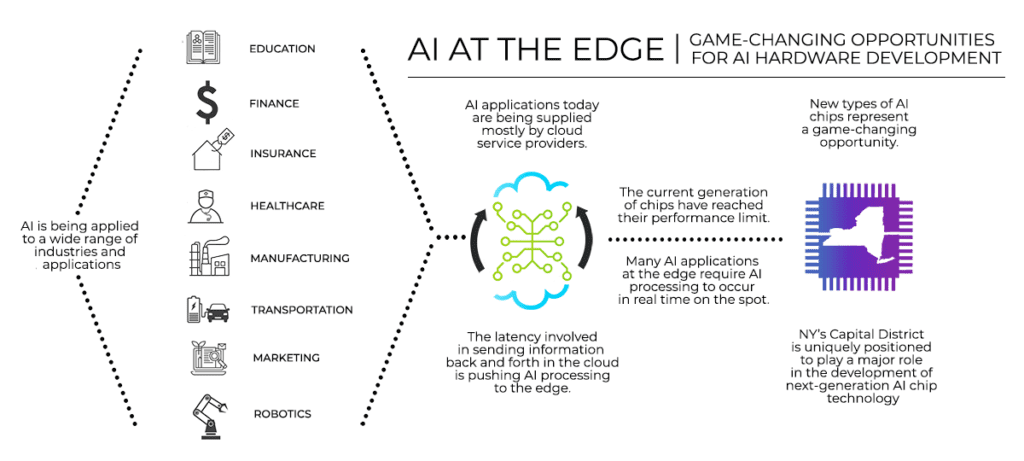The AI Chip Race Creates Opportunities for New Players, including New York’s Capital District
The benefits that businesses and consumers are deriving from AI (artificial intelligence) require a lot of computing power. However, the current generation of processors have hit a performance barrier—the power needed for AI processing is maxed out.
The next wave of AI innovation requires specialized processors designed not only for powering AI applications in traditional large-scale data centers, but also for the rapidly expanding number of devices that require AI processing locally “at the edge.”
The need for AI processing at the edge opens a market opportunity for a whole new set of players to provide AI chips, applications, and solutions. With more than $2 billion being invested by IBM and New York State to create a new AI Hardware Center, The New York State Capital District is perfectly positioned to take advantage of this opportunity.
The need for AI processing at the edge opens a market opportunity for a whole new set of players to provide AI chips, applications, and solutions. With more than $2 billion being invested by IBM and New York State to create a new AI Hardware Center, The New York State Capital District is perfectly positioned to take advantage of this opportunity.
New AI Chips Needed
The infrastructure for running AI applications today is being supplied mostly by cloud service providers like Google, Amazon, and Microsoft in data centers equipped with vast arrays of processors and large pools of storage.
One of the factors pushing AI processing to the edge is the need to eliminate the latency involved in sending information back and forth in the cloud. Many AI applications at the edge require AI processing to occur in real time on the spot.
Another big reason for processing AI at the edge is because that is where much of the data resides. As Steve Roddy, VP of Special Projects inside ARM’s Machine Learning Group, explains, “It simply doesn’t make sense to send all the bits for things like video and audio streaming to the cloud and back down for every situation, every endpoint.”
New Chip Models Needed
The current generation of chips have reached their performance limit and computers today are gaining power not by increasing speed, but by adding more cores, says Graphcore CEO Nigel Toon. The new generation of AI chips requires the development of entirely new architectures optimized for AI processing.
As Electrical Engineering Times reports, “both OEMs and dedicated chip houses will be spending a lot of cash and IP capital on developing SoCs, ASICs/ASSPs, and accelerators that will best implement the most advanced algorithms at the data center and at the edge.”
The winners, says says EE Times, will be the chip makers who have made the best use of processing elements, memory, I/O, and on-chip interconnects to achieve the necessary gains in efficiency and performance required for the next generation of AI solutions.
Game-Changing Opportunity
As ZDnet reports, “AI is the most disruptive technology of our lifetimes, and AI chips are the most disruptive infrastructure for AI.”
The demand for AI processing at the edge, argues Dan Woods in Forbes, has created the next major technology opportunity for new players.
Moreover, as futurithmic points out, “Ownership and control of AI and machine learning represent a level of geopolitical power that will reshape virtually every domain of human activity—social, economic, political, and military.”
The overall AI market opportunity is huge. PWC, for example, forecasts that AI will add $15.7 trillion to the global economy by 2030.

Mega Market
The overall AI market opportunity is huge. PWC, for example, forecasts that AI will add $15.7 trillion to the global economy by 2030.
Within this market, the number of AI devices at the edge is growing exponentially. Tractica estimates that AI edge device shipments will increase from 161.4 million units in 2018 to 2.6 billion units worldwide annually by 2025.
AI chips will represent the lion’s share of growth in the semiconductor market. As EE Times reports, “By 2025, a full five sixths of the growth in semiconductors is going to be the result of AI.”
AI is being applied to a wide range of industries and applications, including manufacturing, finance, insurance, healthcare, education, transportation, marketing, sales, HR, and many forms of robotics and sensing.
NYS Capital Poised for AI Leadership
The need for new types of AI chips represents a game-changing opportunity for new players to enter the field. As Dan Woods notes, “at the edge there will be hundreds of players because there is such diversity of infrastructure, data, and application needs.”
With IBM announcing a $2 billion investment in SUNY Polytechnic Institute to establish an AI Hardware Center, the New York State Capital District is uniquely positioned to play a major role in the development of next-generation AI chip technology.
In addition to IBM’s investment, the New York State Board approved $425 million in grants toward projects at the SUNY Polytechnic Institute campus in Albany. The Public Authorities Control Board voted to approve $300 million in state grants for the IBM AI Hardware Center and $125 million for a partnership with Applied Materials.
These initiatives have the full backing of New York Governor Andrew Cuomo, who said they would solidify the Capital Region’s position as “Tech Valley,” a global hub for innovative research and development.
As part of this initiative, deFacto Global has created the AI Center of Excellence (AICoE), which will serve as a hub for AI solutions in the NYS Capital District. To create the AICOe, deFacto Global is partnering with premier research institutions, leading AI vendors, and experts in the field of applying AI technology. The AICoE is working with SUNY, Applied Materials, and other leading New York State AI organizations to create a unified AI Capital District strategy for achieving success in the new era of AI development.
It will be exciting to see the new technologies and applications that emerge as this new AI era unfolds.
Contact us to learn how deFacto Planning’s built-in AI features and deFacto’s Intelligize.AI service can help you harness the power of AI in your organization.
